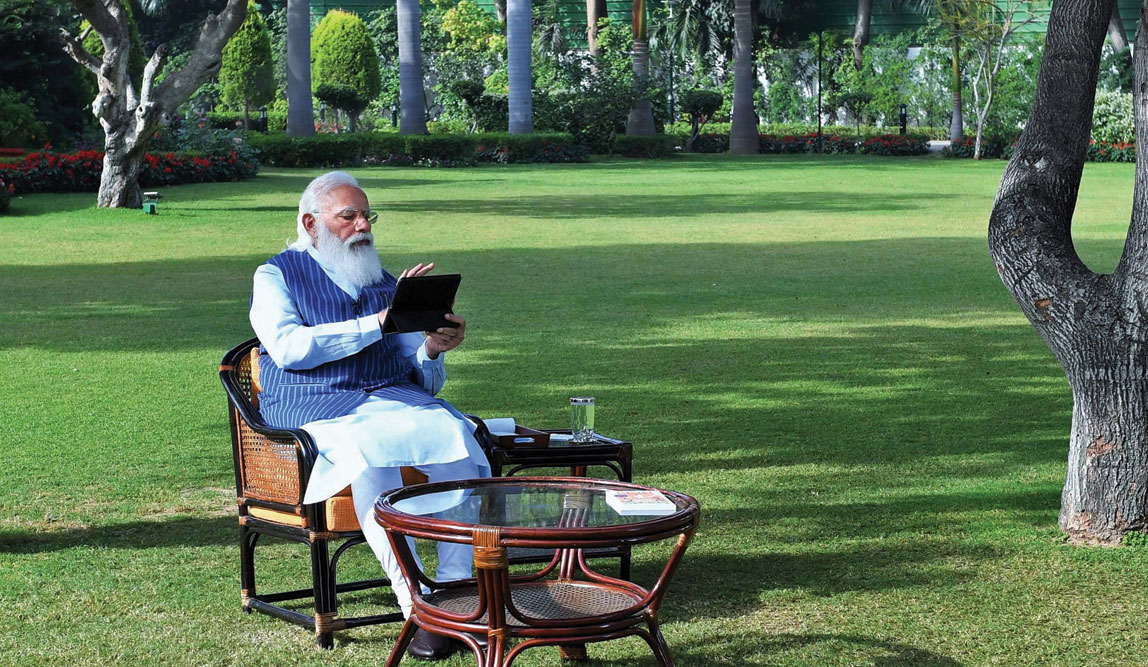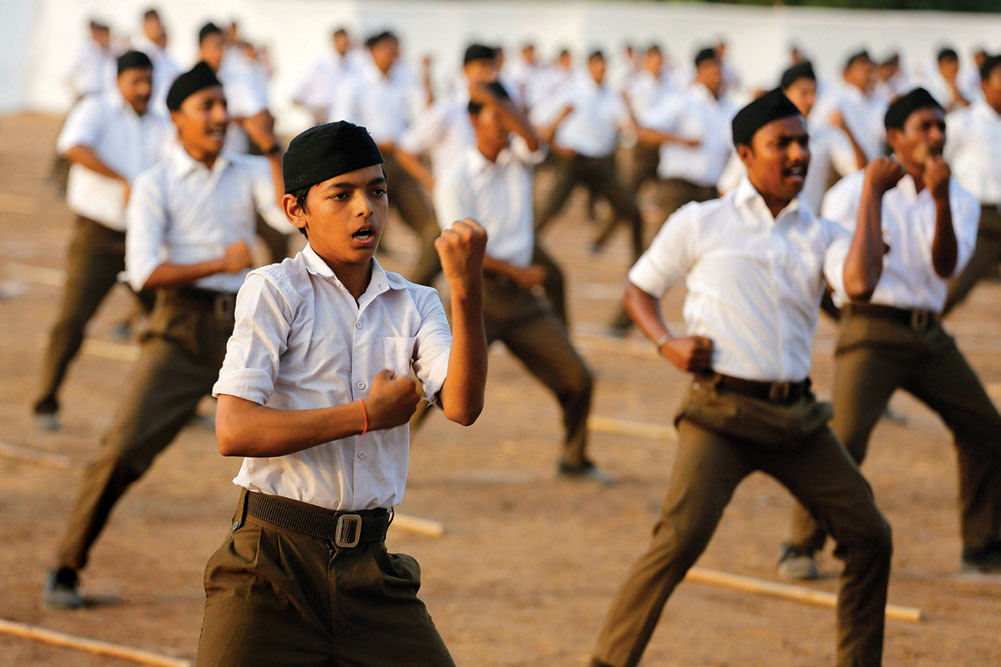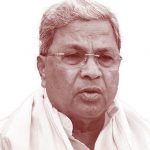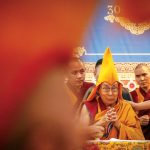The Measure of Moditva
Does the ‘F’ word apply to India?
 Shashi Tharoor
Shashi Tharoor
 Shashi Tharoor
Shashi Tharoor
 |
13 Aug, 2021
|
13 Aug, 2021
/wp-content/uploads/2021/08/Moditva5.jpg)
(Illustration: Saurabh Singh)
MODITVA ARTICULATES A cultural nationalism anchored in the RSS political doctrine of Hindutva, but extending beyond it. On top of the foundation of Hindutva—a reactionary and regressive doctrine, with its roots in the ‘racial pride’ ethos that spawned fascism in the 1920s—it builds the idea of a strong leader, powerful and decisive, who embodies the nation and will lead it to triumph. When a similarly dominant leader, Indira Gandhi, attempted a similar degree of assertion over India’s institutions, she declared Emergency and suspended many democratic processes, only to restore them fully after 22 months, hold a free election, lose it comprehensively and relinquish power. Moditva’s assault on India’s democracy is more subtle and more enduring: the changes it is bringing about to India’s democratic institutions involve nothing as blunt as Emergency decrees, but fundamentally alter the assumptions of their functioning in ways that will inevitably cripple them as effective custodians of the nation’s freedom. The danger to liberal constitutionalism is clear.
Some, particularly on the left, have gone farther than this, evoking the dreaded term ‘fascism’ for Moditva. In a now-famous essay published in the magazine Seminar soon after the 2002 riots (‘Obituary of a Culture’, May 2002), sociologist (and trained clinical psychologist) Ashis Nandy, who had interviewed Narendra Modi in the late 1980s, well before he began his spectacular political rise, laid out this chilling diagnosis. The future prime minister, Nandy wrote, at the time “a nobody, a small-time RSS pracharak trying to make it as a small-time BJP functionary”, gave him a “long, rambling interview” that “left [him] in no doubt that here was a classic, clinical case of a fascist.”
Nandy added, “I never use the term ‘fascist’ as a term of abuse; to me it is a diagnostic category comprising not only one’s ideological posture but also the personality traits and motivational patterns contextualising the ideology. Modi, it gives me no pleasure to tell the readers, met virtually all the criteria that psychiatrists, psycho-analysts and psychologists had set up after years of empirical work on the authoritarian personality. He had the same mix of puritanical rigidity, narrowing of emotional life, massive use of the ego defence of projection, denial and fear of his own passions combined with fantasies of violence—all set within the matrix of clear paranoid and obsessive personality traits. I still remember the cool, measured tone in which he elaborated a theory of cosmic conspiracy against India that painted every Muslim as a suspected traitor and a potential terrorist.”
Nandy is a respected scholar and there is no reason to doubt the objectivity of his analysis. Some elements he identifies are in fact avowed by Modi followers themselves, though as virtues, not failings: the ‘puritanical rigidity’, for instance, is a Modi attribute—he told me himself that, as prime minister, he sees no movies, for instance; he is known neither to drink nor smoke, eats non-spicy fare, enjoys a simple khichdi (usually alone) and frequently observes fasts on specific Hindu occasions, in particular during the Navratri festival, when he only drinks nimbu pani and a cup of tea during the day.
Another is the “narrowing of emotional life” Nandy mentions. Narendra Modi lives alone and maintains little contact with his mother, four brothers or sister, though he has not been above demonstrating his filial devotion by seeking his mother’s blessings on his victory or being photographed wheeling her chair around the prime ministerial garden (before returning her to a life of anonymity away from him). Modi has no relationship to speak of with his blood relatives and advertises this as part of his incorruptibility. At an election rally in Hamidpur in Himachal Pradesh in February 2014, Modi said, “I have no family ties. I am single. Who will I be corrupt for?” adding, “This mind and body is totally devoted to the nation” (NDTV, February 17th, 2014). His siblings are less enthusiastic about his rectitude. “I wish he would help the next generation of our family. But I am sure he won’t,” his younger brother, Prahlad Modi, said after Narendra Modi became prime minister. “He won’t even offer tea to someone without a reason—especially his family” (BBC, May 16th, 2014).

Prahlad Modi is also the source of one of the few negative anecdotes about Modi as a youngster. When he was younger, Narendra Modi liked to fly kites. Being the younger brother, Prahlad would hold the spool of string, or manja, while Narendra Modi did all the flying. “If I refused, he would get angry and he would hit me,” says Prahlad, “I am still scared of him, even today” (ibid).
Narendra Modi has said he sleeps about four hours a night, rises at about 5AM every day to do yoga and meditate, spends 15 minutes reading the news on his iPad (this seems suspiciously little) and has not taken a holiday in nearly two decades. An official response to a Right to Information petition filed in 2016 asking about the number of days of leave Modi had taken since becoming prime minister informed the applicant—in terms unusually obsequious for an RTI response—that he had not taken a single day of leave since coming to power: ”the Prime Minister can be said to be on duty all the time” (Economic Times, October 12th, 2016).
The Moditva blend of a charismatic, austere ruler, corporatism, an imagined utopia (“Achhe Din”), an evocation of ancient glories, an ‘exacerbated nationalism’ and Islamophobia reminds one of Umberto Eco’s famous list of the key ingredients of what he dubbed “Ur-Fascism” (New York Review of Books, June 22nd, 1995), if one allows for the substitution of anti-Semitism by Islamophobia. This is what emboldens those who use the political “F” word in India.
Still, as I explained at length in my book The Paradoxical Prime Minister, I am not prepared to apply the word ‘fascism’ to the Modi regime: it has become a term of political abuse rather than of understanding. And surely Il Duce went much further than BJP would dream of. “The free press was abolished, the labour unions were dismantled, and political dissenters were confined on remote islands,” Eco says of Mussolini’s rule, whereas of Moditva, the same sentence would have to be rewritten as “the free press was emasculated, the labour unions were ignored, and political dissenters were denied prominent platforms in the mainstream media.” Some developments in current Indian politics seem to bode ill for our institutions, but these were much worse under fascism: “Legislative power became a mere fiction and the executive power (which controlled the judiciary as well as the mass media) directly issued new laws,” Eco writes of Mussolini’s rule.
I am not prepared to apply the word ‘fascism’ to the Modi regime: it has become a term of political abuse rather than of understanding. And surely Il Duce went much further than BJP would dream of
Nonetheless, it is instructive to note how many of the 14 common factors of what Umberto Eco describes as “Eternal Fascism” seem to resonate with relevance when applied to the second term of the Modi regime in India. The cult of traditionalism, with BJP grandees tripping over each other to evoke the glories of ancient India; the rejection of modernism, not in the sense of usable technology but of the scientific temper, of the alleged depravity of the modern world and the decadence of modern lifestyles; the cult of action for its own sake and a distrust of intellectualism; the view that disagreement or opposition is treasonous; a fear of difference rather than the ready acceptance of diversity; racism (transmuted, in the Indian context, to Islamophobia); the appeal to a frustrated middle class that is “suffering from an economic crisis or feelings of political humiliation, and frightened by the pressure of lower social groups”; the identification of an external enemy (Pakistan) and a scarcely veiled xenophobia; the tendency to see enemies simultaneously as omnipotent and weak, conniving and cowardly; the rejection of pacifism (evident in Hindutva’s ambivalent relationship with Mahatma Gandhi); the overt contempt for weakness (particularly scorned by RSS); the cult of heroism, especially built around the image projection of Narendra Modi; hyper masculinity (celebrated in repeated evocations of Modi’s supposed 56-inch chest); the selective populism, relying on chauvinist definitions of ‘the people’ that the movement claims to represent (as Eco puts it, “citizens do not act; they are only called on to play the role of the People”); and finally, the heavy usage of ‘newspeak’ and an impoverished discourse of elementary syntax and resistance to complex and critical reasoning. As Umberto Eco says, these factors are all to be found to a greater or lesser degree in Ur-Fascism, and the world must be vigilant whenever they arise. The green shoots of every one of the elements on his list, alas, have begun to sprout in India.
Autonomous public institutions threaten the dominance of the Moditva doctrine because, by design, they are independent institutions, with specialised mandates, commitments and accountabilities, and they consequently challenge, through merely their independent functioning, Modi’s oversized cult of personality. Naturally, when these institutions refuse to convert themselves into rubber stamps for whatever the ruling party wants them to do (thus the standoff between the Reserve Bank of India and the Centre led to Raghuram Rajan’s and then Urjit Patel’s resignations) the Government’s response appears to be to cut these institutions off at the knees or interfere with the institutional independence that is a defining feature of these bodies.
Similarly, the judicial system, traditionally above the cut-and-thrust of the political fray, has come under withering scrutiny since January 2018, when the four most senior judges of the Supreme Court held an unprecedented press conference to question the decisions of the then Chief Justice, Dipak Misra, in allocating cases to his favourite judges as ‘master of the roster’. Their elliptical comments appeared to imply that the chief justice was unduly seeking outcomes to favour the Government. The performance of the impugned chief justice’s successor, Ranjan Gogoi, was even more troubling, though he was never impeached. His role in reducing the fiercely independent apex court to an “executive court”, subserving the Government’s agenda, has been scathingly portrayed by legal luminaries (for the most scathing—and comprehensive—indictment, see Gautam Bhatia’s ‘The Troubling Legacy of Chief Justice Ranjan Gogoi’, The Wire, March 16th, 2020).
IN THE WORDS of the legal analyst Gautam Bhatia, “ex-Chief Justice Gogoi oversaw a drift from a Rights Court to an Executive Court. That is, under his tenure, the Supreme Court has gone from an institution that—for all its patchy history—was at least formally committed to the protection of individual rights as its primary task, to an institution that speaks the language of the executive, and has become indistinguishable from the executive”(ibid). This has added to the considerable damage done over the Modi years to the institutional credibility of the Supreme Court. (The Gogoi tenure was capped by his unprecedented appointment, within weeks of his retirement, to a nominated seat in Rajya Sabha, the Upper House of the Indian Parliament.)
India’s Election Commission—which has enjoyed a proud record of independence and boasts decades-long experience of conducting free and fair elections—has, under BJP rule, been described as behaving like a government department. The Modi Government has also not hesitated to politicise the armed forces, not just bypassing time-honoured principles of seniority in appointing the Army chief, but by elevating a former general to the council of ministers. Its repeatedly using the Army in its political propaganda marked a particularly disgraceful dilution of the principle that national security issues require both discretion and non-partisanship. The politicisation of the Army could easily result in the militarisation of politics, though so far this has remained at the rhetorical level.
The list goes on. A rot seems to have set in at the Central Information Commission (CIC), which suffers a record number of unfilled vacancies, remains intentionally understaffed and whose salaries may now be altered by the Government—a blow to the independence of the body (till the passage of an amendment in 2019, CIC salaries were fixed by law on a par with those of Supreme Court judges; the revised law permits the Government to fix or amend the salaries of individual information commissioners as it wishes, considerably diluting the independence of CIC); and in the Central Statistics Office, which has been accused of manipulating data to make the Government’s economic management stronger, by changing the base year used for GDP calculations, and which witnessed a number of resignations at the top when the Government attempted to suppress official statistical data it found inconvenient (‘NSC Members Resign after Row over NSSO Employment Report’, Livemint, January 30th, 2019; ‘Was Sidelined, Govt Not Releasing Job Figures, Says National Statistics Commission Chief PC Mohanan on Why He Quit’, India Today, January 30, 2019; ‘GDP Base Year Row: What’s the Problem with Re-Basing India’s Growth Calculations’, Business Today, November 13th, 2019). The Comptroller and Auditor-General (CAG), who is supposed to be an independent auditor of government accounts whose reports are taken up by the Public Accounts Committee of Parliament, has traditionally been a respected figure entirely independent of the government; indeed, one CAG, Vinod Rai, essentially brought down the Government that appointed him, through his report on alleged malfeasance in the allocation of 2G telecom spectrum. But under Modi the CAG position has been reserved for favoured bureaucrats who can be trusted not to cross the line: a former home secretary and then an officer so close to the powers-that-be that he served as the first lieutenant-governor of the new Union territory of Jammu and Kashmir, before resigning to take over as CAG (‘Ex J&K Governor Girish Chandra Murmu Sworn in as India’s New CAG’, Business Standard, August 8th, 2020).

As for Parliament, its work has been reduced to a farce, with its frequency of meetings at an all-time low, and with allies and supporters of the ruling party repeatedly having brought sessions to a standstill through disruptions orchestrated by the Government. There could be no more stark indictment of the failure of Parliament to evolve as a public institution than the progressively downward trend in frequency of sittings, accompanied by more frequent disruptions, both of which have undermined the critical deliberative role of a parliament, which the Government has been treating as a noticeboard for the announcement of its decisions rather than as a consultative body. After hailing Parliament as the “temple of democracy”, it seemed as if the Government was willing to destroy the “temple” rather than permit prayers against its misrule to be heard there.
The Government’s lack of interest in parliamentary accountability was brought home during the Covid-19 pandemic when, for months after Parliament was first suspended because of the coronavirus in March 2020, neither it nor its committees were allowed to be convened. Committees could have met virtually even during lockdowns, but permission for video-conferencing was rejected on grounds of confidentiality. While physical meetings of committees were finally permitted, lockdown restrictions reduced participation to a handful of members, with meetings often being cancelled for lack of a quorum, while requests by committee chairmen for hybrid physical and online meetings were denied on grounds of confidentiality. And even in pre-pandemic times, whenever there was a rare opportunity for sensible debate on matters of serious importance to the country, the preference of the Modi regime is the following: the Government will propose; the opposition will oppose; if matters come to a head and a vote is called, the Government’s brute majority will dispose.
ALL THIS IS, of course, sought to be justified on nationalist grounds, particularly the argument that opposition and dissent are by definition anti-national. BJP’s loudly proclaimed fear of ‘anti-nationalism’ is, in itself, anti-national, since Indian nationalism and Indian democracy are inextricably linked. An attack on one is an attack on the other. The fear is that ethnonationalism is taking India towards a peculiar hybrid, a ‘dictatocracy’ which preserves the forms of democracy while brooking no dissent against its dictates.
Nowhere is this more apparent than in the ongoing persecution of India’s more liberal universities. The Government seems entirely unconscious of the classic prescription that the supreme purpose of the university in our republic is to create well-formed minds which can participate in a democracy, whose future depends on citizens’ capacity to scrutinise their elected officials. One purpose of the university is to help us expand our minds in service of that democracy. In a deliberative democracy, universities are meant to be hotbeds of argument, debate and dissent rather than centres of conformity. Universities are where young people find themselves—in many cases through engagement, political passion, ideological fervour and personal involvement—in causes larger than their own academic careers. Many—perhaps most—students grow up in the process and outgrow the more extreme views they adopted out of youthful zeal. But Moditva has no patience for this role of universities: instead they have slapped sedition charges on student protestors and, in an act of horrifying symbolism, parked a tank on the campus of Jawaharlal Nehru University.
The Indian state is not so feeble that a few irresponsible slogans shouted by misguided students can destroy it. But undermining the democratic ethos of the Indian Republic can destroy the essence of the state and of the grand national experiment our nationalist leaders embarked on when the country became free in 1947. By branding dissent as ‘anti-national’ and so illegitimising it, our BJP rulers are betraying the founding idea of an India “where the mind”, in Tagore’s immortal phrase, “is without fear” (Gitanjali).
It should not need saying, but in today’s India, it does: one can criticise the government of the day and be loyal to the nation. Only those of a fascist mindset fail to appreciate the distinction. To define dissent as anti-national is to betray the nationalism of a freedom struggle that was itself built on dissent. We must celebrate a robust and pluralistic Indian democracy, not the fearful brand of governance espoused by the current Government, which sees treason in every tweet and a traitor under every desk.
Modi has allowed free rein to retrograde and often violent forces who conform collectively to Ashis Nandy’s archetype. These elements in the Sangh Parivar have been emboldened by Modi’s continued silence in the face of their repeated atrocities
India’s free press, which ought to be calling the Government’s actions to account, has seemingly been cowed by the overweening power of the Government. A process combining intimidation and co-optation has ensured the minimum of critical voices in the so-called ‘mainstream’ media are raised against such behaviour. If the de-institutionalisation of Indian governance proceeds like this, the greatest danger facing India will be that of the public losing faith in the system altogether—with incalculable consequences for the country’s biggest asset, its democracy.
Moditva certainly relies on radiating an impression of strength: it follows a policy of ‘never apologise, never explain’. Unlike the Congress-led United Progressive Alliance Government that preceded the National Democratic Alliance Government he heads, Modi has never allowed the opposition, the media or even widespread public disapproval to force a member of his Government out of office. When his External Affairs Minister Sushma Swaraj was revealed to have gone behind the back of her own foreign secretary and the Indian high commissioner in the UK to privately advise the British high commissioner in Delhi that her ministry would not object if a travel document were provided to an Indian fugitive economic offender in London, Lalit Modi—a resigning offence in any democracy, especially since the fugitive was her lawyer husband’s client—Modi refused the opposition clamour for her resignation and prevailed (‘New Lalit Modi Emails Renew Conflict of Interest Charges for Sushma Swaraj’, NDTV, July 2nd, 2015). He similarly stuck with two ministers who had made offensive public statements (one of which divided the people of India into Ramzade and Haramzade, or followers of Ram and bastards), despite an opposition outcry in Parliament. Modi’s stubbornness in all these cases signalled that he would not give in to pressure; this attitude of invulnerability itself shored up the perception of strength around his Government, by contrast with earlier Governments which had caved in to public pressure.
Modi was similarly unmoved by calls to ‘unfollow’ social media supporters of his who had issued vile messages celebrating the murder of journalist Gauri Lankesh in September 2017. Modi’s silence amounted to tacit support for abusive Hindu rightwing trolls, but he stood by them even in the face of a social media uproar, with the hashtag #BlockNarendraModi trending on Twitter. The prime mininster was unmoved, and again the campaign against him ran out of steam. His imperturbability and resoluteness reinforced his strongman image, while on all these issues, his critics subsided into a sullen silence.
None of this, however, necessarily adds up to a fascist personality, though Nandy is the expert, not I. It must be said, too, that Modi has not conducted himself in office in the manner Nandy’s impressions and analysis would have suggested. He has repeatedly spoken of being a prime minister for all Indians; arguably his most effective slogan has been ‘sabka saath, sabka vikas’. But as I have pointed out throughout his term of office, he has allowed free rein to retrograde and often violent forces who conform collectively to Nandy’s archetype. These elements in the Sangh Parivar have been emboldened by Modi’s continued silence in the face of their repeated atrocities and empowered by his stirring rhetoric that implicitly, and sometimes explicitly, attacks Muslims (see MK Venu’s ‘If Left Can Condemn Maoists, Why Is Narendra Modi Silent on Sanghis?’, Firstpost, August 19th, 2014; ‘Modi Needs to Do More to Condemn Hate Mongers within Sangh Parivar’, Times of India, April 24th, 2014).
Moditva certainly relies on radiating an impression of strength: it follows a policy of ‘never apologise, never explain’
And yet it is precisely Modi’s willingness to leap beyond his ideological past that makes one feel that a term like ‘fascist’ is too much too soon. Fascism surely requires two elements—an outright rejection of democracy, and a ruthless definition and application of repressive law and order—that are mostly absent in Moditva. Living in democratic India, I am reluctant to follow Nandy in applying the label to Narendra Modi. But then I read Fintan O’Toole in the Irish Times on July 21st, 2018 about the Western world: “Fascism doesn’t arise suddenly in an existing democracy. It is not easy to get people to give up their ideas of freedom and civility. You have to do trial runs that, if they are done well, serve two purposes. They get people used to something they may initially recoil from; and they allow you to refine and calibrate. This is what is happening now and we would be fools not to see it” (‘Trial Runs for Fascism Are in Full Flow’, June 26th, 2018). And then I wonder, applying these words to India, and to the ‘new normal’ that has dawned since 2014, are we also fools not to see it?
Historically there are certain aspects of fascism that do seem to have appeared in recent years in India—the demonisation of minorities within society to the extent that they are made to feel insecure (see Nazia Erum’s ‘BJP Is Done Marginalising Indian Muslims. It Has Now Started Demonising Them’, Scroll.in, July 21st, 2018.); the condemnation and reviling of critics to the point where the use of violence against them seems permissible; the whipping up of nationalist feelings, coupled with an identification of the ruling party with the nation and a disparagement of dissent as anti-national and disloyal to the country; an assertive foreign policy, especially towards neighbours, that is belligerent to the point of being willing to risk war; and contempt for rules-based liberal democracy and its independent institutions. O’Toole warns of “the generation of tribal identities, the division of society into mutually exclusive polarities” that have indeed been a feature of Moditva. He warns, too, of the rigging of elections, noting that historically, fascism has come to power on a minority vote and then consolidated itself through fear and intimidation. Seen through this prism, BJP’s 37 per cent certainly looks more ominous. “And fascism,” he continues, “needs a propaganda machine so effective that it creates for its followers a universe of ‘alternative facts’ impervious to unwanted realities.” Again, echoes of India resonate (ibid).
And the final ingredient O’Toole identifies is the intangible one: the undermining of moral boundaries, which inures people to accepting acts of extreme cruelty, particularly towards a despised ‘outgroup’ that is portrayed as a threat. At a time when it seems it might be safer in some parts of India to be a cow than a Muslim, is O’Toole right that the test-marketing for something more ominous is already happening? With mob lynchings creating an atmosphere of fear among many, BJP has given rise to a culture of impunity.
The thoughtful columnist Santosh Desai, without mentioning the word ‘fascism’, writes of the “atmosphere of fear” being “achieved not only through harsh punitive measures, but through a complex and elaborate network of actions, real and symbolic… The sense of threat is more palpable. This government is deemed capable of much more than what it has actually done; the fear is evoked by latent violence in the body language of the government rather than in its actions alone. ‘Violence in the air’ is a more effective way of fostering self-censorship than any direct method… Fear reproduces itself thanks to the elegant design of the ecosystem of intimidation that is in place today… Showing signs of fear itself becomes proof—unless you are an anti-national, why should you be afraid?” (‘An Ecosystem of Fear?’, Times of India, September 3rd, 2018).
It is difficult to argue that Desai is being alarmist. His tone is measured as he goes on: “The calibrated use of reward and punishment, the taking of action against victims rather than perpetrators, the penetration of virtually every institution that matters, the creation of voluntary and vocal cheerleaders for the actions of the state, the regular encouragement given from the highest level of the government to those that carry out intimidation, the periodic acts of brutal violence that indicate that the threats are not only symbolic in nature, the breeding of several kinds of private armies that publicly display their muscle, the succession of violently intemperate statements made by minor party leaders, and actions like the arrest of activists on charges that align with the larger narrative that is being built—these are all part of this ecosystem of fear.” If one were to look for an Indian echo to O’Toole’s anxiety about the West, Desai’s “ecosystem of fear” is troubling enough. Fear is as worrying an ‘f’ word as fascism.
It is a measure of my own concern about the substance of Nandy’s charge—rather than my ambivalence over the word for it—that I was struck by a paragraph in Madeleine Albright’s recent Fascism: A Warning, in which she warns the readers about the lasting damage that has been caused to her nation by former US President Donald Trump: he has “degraded political discourse… shown an astonishing disregard for facts, libelled his predecessors… touted mindlessly nationalistic economic and trade policies, vilified immigrants and the countries from which they come and nurtured a paranoid bigotry toward the followers of one of the world’s foremost religions” (New York: HarperCollins, 2018).
Much of this description finds resonance in present-day India: the degrading of political discourse from the very top, the disregard for facts, the constant denigration of his predecessors (Modi speaks as if Indian political history before him was a black hole of failure and claims that Indians became proud of India only after his victory); the mindless economic policy of demonetisation (which all but destroyed the Indian economy); and the vilification of immigrants and religious minorities—it helps that the two can be conflated, since the Bangladeshi migrants are overwhelmingly Muslim (‘India Will Not Take Rohingya Refugees, They Are a Security Threat, Says BJP’, Deccan Chronicle, September 17th, 2017). If, as Albright suggests, all this amounts to warning signs of looming fascism, then Indians must consider themselves warned. Even if the ‘f’ word cannot yet be applied to India, its green shoots may have begun to appear.

/wp-content/uploads/2025/07/Cover_Dalai-Lama.jpg)












More Columns
From Entertainment to Baiting Scammers, The Journey of Two YouTubers Madhavankutty Pillai
Siddaramaiah Suggests Vaccine Link in Hassan Deaths, Scientists Push Back Open
‘We build from scratch according to our clients’ requirements and that is the true sense of Make-in-India which we are trying to follow’ Moinak Mitra